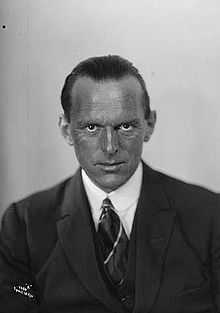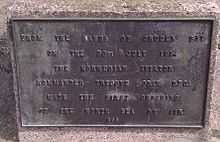Tryggve Gran
| Tryggve Gran | |
|---|---|
 Major Tryggve Gran in 1923 | |
| Full name | Jens Tryggve Herman Gran |
| Born |
20 January 1888[1] Bergen, Norway |
| Died |
8 January 1980 (aged 91) Grimstad, Norway |
| Monuments | Memorial plaque at Cruden Bay, Scotland |
| Nationality | Norwegian |
| Spouse |
Lily St. John (m. 1917–21) (div.) Ingeborg Meinich (m. 1923) (div.) Margaret Schønheyder (m. 1941–80) |
| Aviation career | |
| Known for | Aviator, explorer and author |
| Famous flights | First heavier-than-air flight across the North Sea (Scotland to Norway, 30 July 1914) |
| Air force | Norwegian Army Air Service, Royal Flying Corps, Royal Air Force |
| Battles | Western Front (1917), North Russia Campaign (1919) |
| Rank | Major (Squadron Leader) |
| Awards | DSC, MC |
Jens Tryggve Herman Gran DSC, MC (20 January 1888 – 8 January 1980) was a Norwegian aviator, explorer and author.[2] He was the skiing expert on the 1910–13 Scott Antarctic Expedition and was the first person to fly across the North Sea.
Background
Tryggve Gran was born in Bergen, Norway, growing up in an affluent family dominant in the shipbuilding industry. His great-grandfather Jens Gran Berle (1758–1828), had founded a shipyard in the Laksevåg borough of the city of Bergen. His father, the shipyard owner, died when Tryggve was only five years old. In 1900, after school in Bergen and Lillehammer, Gran was sent to a school in Lausanne, Switzerland for a year, where he learned some German and French. Three years later, he met the German emperor, Wilhelm II, a common guest with the families of Tryggve's friends. Meeting the emperor made an impact on the then 14-year old boy, who from that moment on wanted to become a naval officer. At this time, he had several years behind him as a member of the Nygaards Battalion, one of Bergen's buekorps. He entered naval college in 1907 and graduated in the spring of 1910.[3]
Career

Gran took an interest in science and exploration which in 1910 led to Fridtjof Nansen recommending his services to Robert Falcon Scott, who was in Norway at the time preparing for an expedition to the Antarctic and testing the motor tractor he intended to take with him. Scott was impressed with Gran, who was an expert skier, and convinced him to take part in the Terra Nova Expedition as ski instructor to Scott’s men.
Arriving in Antarctica in early January 1911, Gran was one of the 13 expedition members involved in the laying of the supply depots needed for the attempt to reach the South Pole later that year. From November 1911 to February 1912, while Scott and the rest of the Southern party were on their journey to the Pole, Gran accompanied the geological expedition to the western mountains led by Griffith Taylor. In November 1912, Gran was part of the 11-man search party that found the tent containing the bodies of the Polar party. After collecting the party’s personal belongings the tent was lowered over the bodies of Scott and his men and a 12-foot snow cairn was built over it. A pair of skis were used to form a cross over their grave. Gran travelled back to the base at Cape Evans wearing Scott's skis, reasoning that at least Scott's skis would complete the journey. Before leaving Antarctica he made an ascent of Mount Erebus with Raymond Priestley and Frederick Hooper in December 1912, an occasion which nearly ended in disaster when an unexpected eruption caused a shower of huge pumice blocks to fall around him. Gran was later awarded the Polar medal by King George V.

On his return voyage, Gran met the Irish aviator Robert Loraine, and immediately took an interest in aviation. Gran became a skilled pilot at Louis Blériot's aviation school in Paris, and on 30 July 1914, Gran became the first pilot to cross the North Sea. Taking off in his Blériot XI-2 monoplane, Ca Flotte, from Cruden Bay, Scotland, Gran landed 4 hours 10 minutes later at Jæren, near Stavanger, Norway, after a flight of 465 kilometres (289 mi).
Only five days later, the United Kingdom entered the First World War. Gran, now a first lieutenant in the Norwegian Army Air Service, volunteered for service with the Royal Flying Corps. He was rejected because of Norway's neutrality. However, the rejection did not stop Gran. Under the identity of "Captain Teddy Grant" of Canada, he was admitted to the RFC, serving in 1916 with No.39 Squadron on Home defence, flying the Sopwith Camel on the Western Front with No. 70 Squadron during 1917, and later commanding various Royal Air Force units in Arkhangelsk and North Russia during the Allied intervention in 1919. Gran himself claimed to have shot down German ace Hermann Göring in a dogfight on 8 or 9 September 1917. He discovered this when he became acquainted with Göring after the war, and compared his flight logs with Göring's. It could however not be verified that it was Gran who shot down Göring's plane.
During the war, the RAF promoted Gran to the rank of Major, and awarded him the Military Cross for distinguished war service.
After the war, Gran started holding lectures on aviation and his journeys to the polar areas, as well as writing books. In 1919 he was the first man to fly from London to Stockholm. In 1928, he led a search party to find polar explorer Roald Amundsen, lost flying while trying to discover the fate of Umberto Nobile's North Pole expedition on board the Airship Italia.
During the Second World War, Gran was reportedly a member of NS, Vidkun Quisling's Nationalist Party. The NS used Gran's hero-like status in their war propaganda, and in 1944, a commemorative stamp was issued to mark the 30th anniversary of Gran's flight across the North Sea. It has been speculated Gran feared reprisals from the pro-German fascist party because of his commitment to the Royal Air Force in the First World War. Others have speculated that his friendship with Göring and bitterness over not being offered a full-time job in the Norwegian Army Air Service may have been reasons for Gran to support the NS during the Nazi occupation of Norway.
After a trial in 1948, Gran was found guilty of treason and sentenced to a prison term of 18 months. The remainder of his life was devoted principally to writing books.
Personal life

Gran was married three times. First in 1917 with actress Lily St. John, marriage dissolved 1921; Secondly in 1923 with Ingeborg Meinich (1902–1997) with whom he had two daughters, the marriage dissolved, lastly in 1941 with Margaret Schønheyder, a renowned portrait painter. With his last wife, he had a son, Hermann who was born in 1944.
Gran was also a gifted football player, earning 1 cap for Norway in 1908. This was Norway's first ever international match, and was played against Sweden in Gothenburg. Sweden beat Norway 11-3.
Tryggve Gran died in his home in Grimstad, Norway on 8 January 1980 aged 91. A memorial was unveiled in Cruden Bay during 1971.
Honors
- Order of St. Olav (Norwegian, 1915 – returned in 1925)
- Distinguished Service Cross (British, First World War)
- Military Cross (British, First World War)
Bibliography
- Hvor sydlyset flammer – (1915)
- Under britisk flagg: krigen 1914–18 – (1919)
- Triumviratet – (1921)
- En helt: Kaptein Scotts siste færd – (1924)
- Mellom himmel og jord – (1927)
- Heia – La Villa – (1932)
- Stormen på Mont Blanc – (1933)
- La Villa i kamp – (1934)
- Slik var det: Fra kryp til flyger – (1945)
- Slik var det: Gjennom livets passat – (1952)
- Kampen om Sydpolen – (1961)
- Første fly over Nordsjøen: Et femtiårsminne – (1964)
- Fra tjuagutt til sydpolfarer – (1974)
- Mitt liv mellom himmel og jord – (1979)
See also
References
Other sources
- Bomann-Larsen, Tor (1993) Den evige sne – En skihistorie om Norge (Cappelen) ISBN 82-02-13801-9
External links
- Tryggve Gran – Norges første flyverhelt – Tidsskrift for Den norske Lægeforening
- Kopierer flypionér – Aftenposten 12/3 2006
|